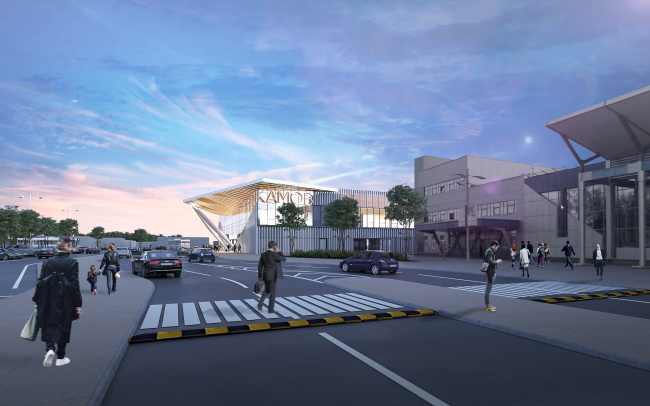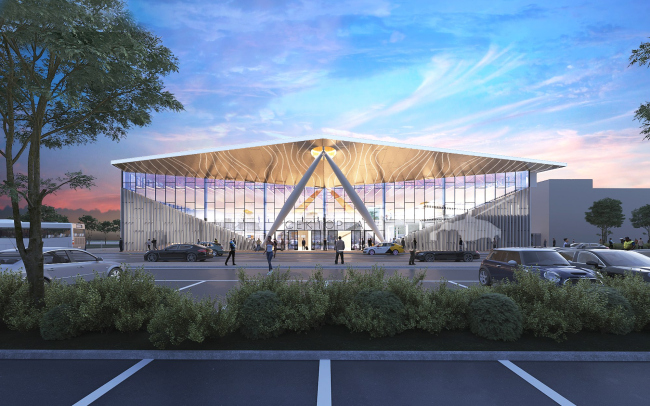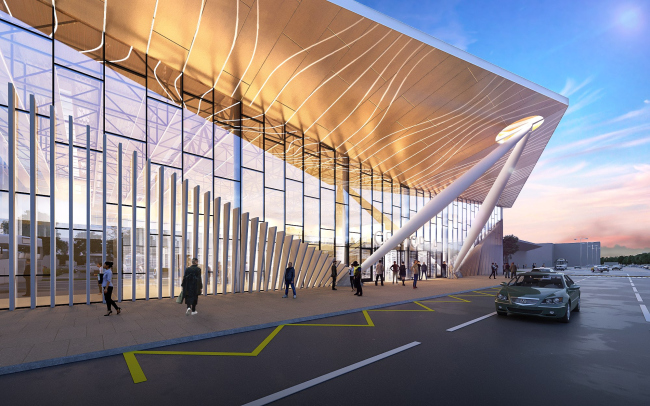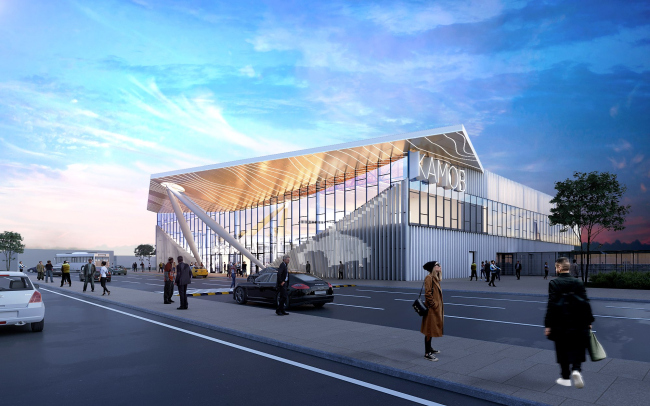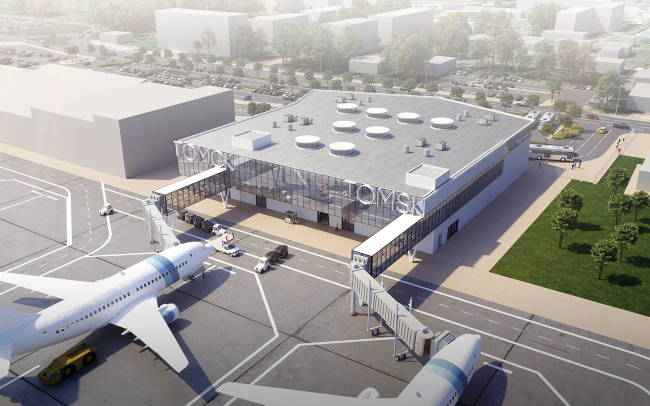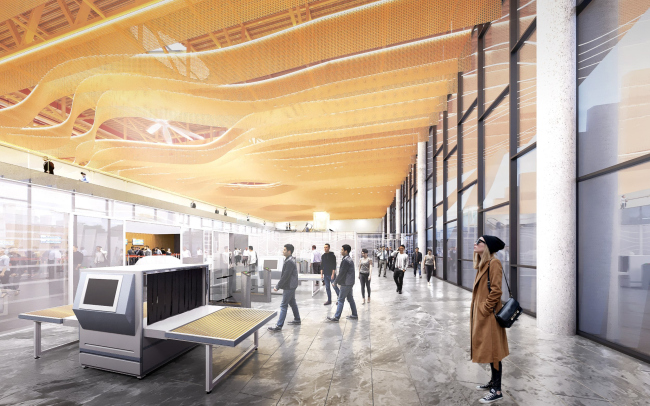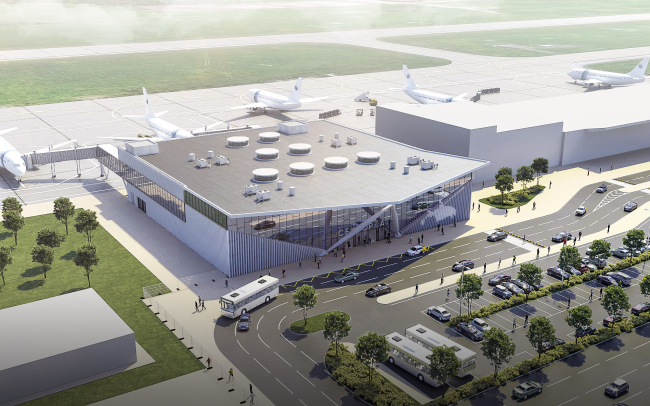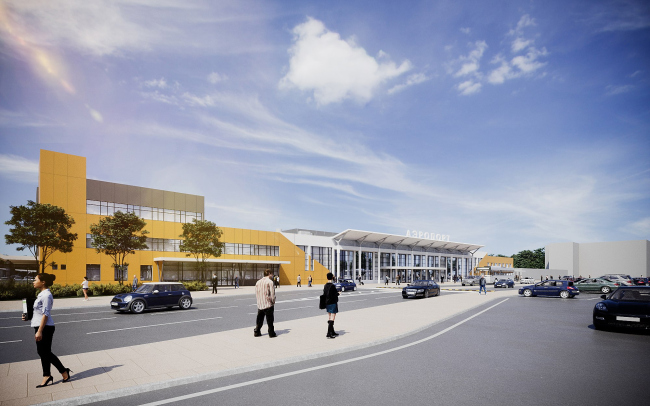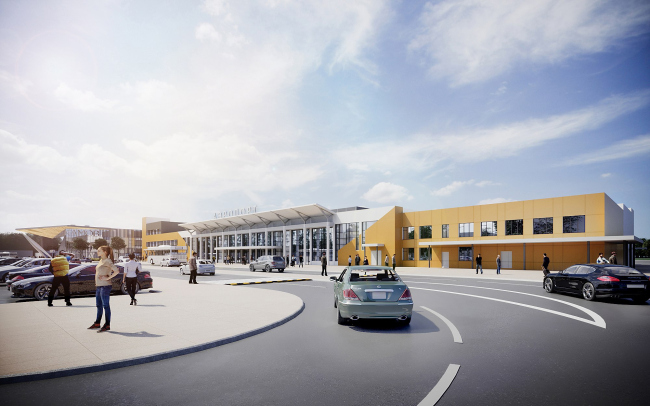|
Published on Archi.ru (https://archi.ru) |
|
| 16.12.2022 | |
|
Off We Go! |
|
|
Alyona Kuznetsova |
|
| Architect: | |
| Andrey Asadov | |
| Alexander Asadov | |
| Studio: | |
| ASADOV architects | |
|
The new terminal of the Tomsk airport is being designed by ASADOV bureau. The architects keep on developing its identity, building the imagery upon the inventions of Nikolai Kamov, whose name the airport bears. The result is laconic, light, and, as always, levitating. The Tomsk airport is situated a couple of dozen kilometers away from the city, near the settlement of Bogashevo. The construction of the international terminal was planned still in 2004, when the city celebrated its 400th anniversary, but at that point the city only managed to modernize the of the old terminal and the adjacent plaza. International flights began flying from Tomsk in 2013, and since then passenger traffic has been steadily growing: almost 800 thousand people live in the Tomsk urban agglomeration alone, and the airport serves other cities as well. In 2019, large-scale work finally began: reconstruction of the runway, repair of access roads and construction of a new terminal by the project of Asadov bureau. The expected area of the facility is 7000 square meters; after the construction is finished, the total area of both Tomsk terminals will be 17,300 square meters. Tomsk airport named after Nikolai KamovCopyright: © ASADOV ArchitectsAt this point, we can recall that the main feature of Nikolai Kamov’s helicopters was a , in which a pair of rotors installed in parallel rotates in opposite directions on a single geometric axis. It seems that in the solution of the main facade one can see some vague allusions to this invention – not literal, of course, but still quite readable: the wings, the air streams, the axles and blades definitely play an important part in the airport’s imagery. In one brisk motion, pointed from the bottom upwards and from the edges towards the center, two large spindle-like columns converge in the center before the main entrance. The entire facade is determined by their symmetrical impulse: it looks as though the incoming passengers are welcomed by a giant “emerging” aircraft that unfolds the golden “wing” of the marquee reflected in the glass of the facade. At the same time, a row of lamellas below is smoothly bent – the way grass would underneath rotating blades; the analogy is further strengthened by the images of helicopters on the metallic surfaces. The resulting image is something in the middle between a hang glider and a rotorcraft. Tomsk airport named after Nikolai KamovCopyright: © ASADOV ArchitectsTomsk airport named after Nikolai KamovCopyright: © ASADOV ArchitectsOn the side, the similarity between the marquee and a hang glider is particularly strong; the lines are simple and laconic, and the “forward and upward” impulse makes one think not just about the theme of flight, quite justified in this case, but also some retro-note, remindful of the Worker and Kolkhoz Woman monument, and even of the reserved and light style of the Soviet terminals. Let us also take a look at the characters of the “Kamov” name – its slender font looks very much like the that was used in the airport during the Soviet time. A font just as slender is used to write the city name of Tomsk from the side of the runways and boarding bridges. Tomsk airport named after Nikolai KamovCopyright: © ASADOV ArchitectsTomsk airport named after Nikolai KamovCopyright: © ASADOV ArchitectsCurrently, it is yet unknown what the interiors of the terminal will ultimately look like, but within the project the principle of the connection between the outside and inside solutions was fully implemented. Behind the golden marquee in the glowing waves on the inside, there is a ceiling of the same color with circular skylights, in which the bladed fans are installed. These put one in the mind of art house cinema, but even more about helicopters. The smooth waves of the noise-canceling suspended from the ceiling visualize the streams of air “moved by the blades”, and, absorbing the noise, at the same time mask the bearing structures – and by these economical means form a “living” and nonlinear surface, positive-looking and glowing with yellow warmth. This is cost-effective, cozy, positive, and, thanks to the yellow color, even jolly-looking. Let’s live and see how the interior solution will be implemented. Tomsk airport named after Nikolai KamovCopyright: © ASADOV ArchitectsTomsk airport named after Nikolai KamovCopyright: © ASADOV ArchitectsThe skylights on the roof also continue the theme of modernist roots and unassuming Soviet expressiveness: their cylinders are shifted upwards, and, when viewed from above, they look like buttons on a dashboard – so that the “fifth facade” of the terminal (which sometimes is indeed visible from the airplane cabin!) is also carefully thought out. At the same time, the similarity between the “button” skylights and the large colored “mushrooms” of Pulkovo-1 seems rather obvious. Tomsk airport named after Nikolai KamovCopyright: © ASADOV ArchitectsTomsk airport named after Nikolai KamovCopyright: © ASADOV ArchitectsThe new terminal is connected to the old one with a covered passage. The ASADOV architects proposed the option of re-cladding the facades of the terminal: it is also dominated by light gray and warm yellow, and the old terminal also has a wing-like marquee, so that the buildings should turn into a single complex. Tomsk airport named after Nikolai KamovCopyright: © ASADOV ArchitectsTomsk airport named after Nikolai KamovCopyright: © ASADOV Architects |
|
